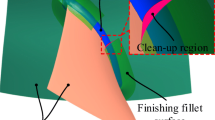Abstract
The layer-by-layer machining approach is extensively used in both pocket and surface roughing process. Traditionally, the machining area is bounded by the intersecting curve of the part model and slicing plane. However, for the complex 3D pocket composed of inclined faces and groove feature, part of the area may be inaccessible for the cutting tool, resulting in interferences in the rough machining process. To tackle the problem, a novel algorithm that can avoid interferences is proposed. In this method, some basic terms such as static machining area (SMA), fringe edge (FE), and area side property (ASP) are described at first. The SMA can be generated through splitting the original machining area by the projection lines of FEs. Based on the ASP, the projection lines and original boundaries can be divided into two types: boundary line (BL) and non-BL. The boundaries of SMA can be constructed by linking BLs based on the accessibility analysis method. At last, two case studies are given to verify the feasibility and effectiveness of the proposed approach. The results show that the proposed algorithm can eliminate the interferences in the machining process.
Similar content being viewed by others
References
Liu Z, Li X, Song Y, Yi B, Chen F (2016) Lofting-based spiral tool path generation algorithm for milling a pocket with an island. Int J Adv Manuf Technol:1–10
Heo EY, Kim DW, Lee JY, Lee CS, Chen FF (2011) High speed pocket milling planning by feature-based machining area partitioning. Robot Comput-Integr Manuf 27(4):706–713
Kiswanto G, Lauwers B, Kruth JP (2007) Gouging elimination through tool lifting in tool path generation for five-axis milling based on faceted models. Int J Adv Manuf Technol 32(3):293–309
Narayanaswami R, Choi Y (2001) NC machining of freeform pockets with arbitrary wall geometry using a grid-based navigation approach. Int J Adv Manuf Technol 18(10):708–716
Chen ZC, Fu Q (2011) An optimal approach to multiple tool selection and their numerical control path generation for aggressive rough machining of pockets with free-form boundaries. Comput Aided Des 43(6):651–663
Zhang M, Liu W, Yang H (2010) Complex pocket milling region automatic identification method. Zhongguo Jixie Gongcheng (China Mechanical Engineering) 21(18):2224–2228 in chinese
Park SC, Choi BK (2001) Boundary extraction algorithm for cutting area detection. Comput Aided Des 33(8):571–579
Yang JZ, Wang QF, Huang ZD, Chen G (2007) Cutting area extraction from a Z-map model. Int J Adv Manuf Technol 33(9–10):1010–1016
Guo B, Cheng X, Peng Q, Dai N (2015) A novel algorithm for the extraction of machining areas based on morphological image processing. Int J Comp Integ Manu 28(12):1350–1359
Zhou M, Zheng GL, Luo ZB, Chen SL (2015) Algorithm for recognizing multi-axis surface feature in aircraft structural parts based on main face extension. Journal of Computer-Aided Design & Computer Graphics 27:2376–2383 in chinese
Tang YL (2013) Automatic NC Programming techniques for profile groove and Rib’s top planar face in aeronautic parts [dissertation]. Beihang University, China in chinese
Kim HC, Lee SG, Yang MY (2006) A new offset algorithm for closed 2D lines with islands. Int J Adv Manuf Technol 29(11–12):1169–1177
Midany TT, Elkeran A, Tawfik H (2009) A sweep-line algorithm and its application to spiral pocketing. International Journal of CAD/CAM:2(1)
Held M, Spielberger C (2009) A smooth spiral tool path for high speed machining of 2D pockets. Comput Aided Des 41(7):539–550
Xu J, Sun Y, Zhang X (2013) A mapping-based spiral cutting strategy for pocket machining. Int J Adv Manuf Technol 67(9–12):2489–2500
Banerjee A, Feng HY, Bordatchev EV (2012) Process planning for floor machining of 2½D pockets based on a morphed spiral tool path pattern. Comput Ind Eng 63(4):971–979
Lin Z, Fu J, Shen H, Yao X (2015) Smooth contour-parallel tool path generation for high-speed machining through a dual offset procedure. Int J Adv Manuf Technol 81(5–8):1233–1245
Makhe A, Frank MC (2010) Polygon subdivision for pocket machining process planning. Comput Ind Eng 58(4):709–716
Mansor MSA, Hinduja S, Owodunni OO (2006) Voronoi diagram-based tool path compensations for removing uncut material in 2½D pocket machining. Comput Aided Des 38(3):194–209
Zhou M, Zheng GL, Chen ZC (2016) An automated CNC programming approach to machining pocket with complex islands and boundaries by using multiple cutters in hybrid tool path patterns. Int J Adv Manuf Technol 83(1–4):407–420
Zhang S, Li Y, Liu C, Liu X (2013) Loop-analysis-based automatic creation method for bottom finish machining region of pocket feature in aircraft structural parts. Zhongguo Jixie Gongcheng (China Mechanical Engineering) 24:1728–1733 in chinese
Chen SL, Zheng GL, Zhou M, Du BR, Chu HZ (2013) Process-scheme-driven automatic construction of NC machining cell for aircraft structural parts. Chin J Aeronaut 26:1324–1335
Chen J, Zheng GL, Luo ZB (2015) Method of automatic iso-surface segmentation for NC machining. Journal of Computer-Aided Design & Computer Graphics 27:924–929 in Chinese
Zhou M, Zheng GL, Chen SL (2016) Identification and looping tool path generation for removing residual areas left by pocket roughing. Int J Adv Manuf Technol:1–14
Zhou YB, Li YG, Wang W (2011) A feature-based fixture design methodology for the manufacturing of aircraft structural parts. Robot Comput-Integr Manuf 27(6):986–993
Ohtake Y, Belyaev A, Seidel HP (2004) Ridge-valley lines on meshes via implicit surface fitting. ACM Transactions on Graphics (TOG) 23(3):609–612
Author information
Authors and Affiliations
Corresponding author
Rights and permissions
About this article
Cite this article
Zheng, Z., Zheng, G., Zhou, M. et al. An algorithm for precise machining area computation in rough machining of complex 3D pocket. Int J Adv Manuf Technol 92, 47–56 (2017). https://doi.org/10.1007/s00170-017-0051-5
Received:
Accepted:
Published:
Issue Date:
DOI: https://doi.org/10.1007/s00170-017-0051-5



